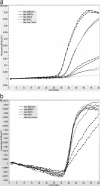Single-run, parallel detection of DNA from three pneumonia-producing bacteria by real-time polymerase chain reaction
- PMID: 15681485
- PMCID: PMC1867508
- DOI: 10.1016/S1525-1578(10)60019-0
Single-run, parallel detection of DNA from three pneumonia-producing bacteria by real-time polymerase chain reaction
Abstract
A molecular assay for parallel detection of three bacteria, Chlamydia (C.) pneumoniae, Legionella (L.) spp., and Mycoplasma (M.) pneumoniae, in clinical specimens by a set of real-time polymerase chain reactions (PCRs) in a single run was evaluated. Bacterial DNAs were extracted by an automated DNA extraction protocol on the MagNA Pure LC System. Amplification and detection were done by real-time PCR on the LightCycler (LC) instrument. For amplification, specific oligonucleotides derived from the 16s rRNA genes of C. pneumoniae, L. spp., and M. pneumoniae were used. The three assays were complemented with an internal control (IC), a specially designed DNA fragment which contains the specific primer binding sites for the three PCRs. The IC was added to the samples, co-extracted, and co-amplified. Primers and hybridization probes were designed to suit one LC PCR program. LC PCRs were established, detection limits were determined, and clinical samples were tested. The detection limits were found between 5.0 and 0.5 IFU/CFU per PCR reaction for each of the bacteria. A total number of 100 clinical specimens were tested for validation of the molecular assay. Tested samples included 63 bronchoalveolar lavages (BALs) and 37 induced sputa specimens. The internal control was detected in all negative and low-positive samples; no inhibition was found throughout the whole study. Additionally, samples underwent testing by culture for L. spp., and M. pneumoniae; for C. pneumoniae, the serological microimmunofluorescence (MIF) test was used. In conclusion, the developed set of LC PCR assays permits parallel detection of C. pneumoniae, L. spp., and M. pneumoniae in a single LC run. This molecular assay may lead to accurate and early diagnosis of pneumonia produced by these three types of bacteria. The assay proved to be suitable for the high-throughput routine diagnostic laboratory.
Figures


Similar articles
-
Qualitative detection of Legionella species in bronchoalveolar lavages and induced sputa by automated DNA extraction and real-time polymerase chain reaction.Med Microbiol Immunol. 2002 Oct;191(2):119-25. doi: 10.1007/s00430-002-0129-y. Epub 2002 Aug 29. Med Microbiol Immunol. 2002. PMID: 12410352
-
Development and evaluation of Chlamylege, a new commercial test allowing simultaneous detection and identification of Legionella, Chlamydophila pneumoniae, and Mycoplasma pneumoniae in clinical respiratory specimens by multiplex PCR.J Clin Microbiol. 2005 Jul;43(7):3247-54. doi: 10.1128/JCM.43.7.3247-3254.2005. J Clin Microbiol. 2005. PMID: 16000443 Free PMC article.
-
Evaluation of different nucleic acid amplification techniques for the detection of M. pneumoniae, C. pneumoniae and Legionella spp. in respiratory specimens from patients with community-acquired pneumonia.J Microbiol Methods. 2008 Jun;73(3):257-62. doi: 10.1016/j.mimet.2008.02.010. Epub 2008 Mar 10. J Microbiol Methods. 2008. PMID: 18378345
-
[Atypical pneumonia].Orv Hetil. 2005 Aug 21;146(34):1759-66. Orv Hetil. 2005. PMID: 16184877 Review. Hungarian.
-
The role of atypical pathogens: Mycoplasma pneumoniae, Chlamydia pneumoniae, and Legionella pneumophila in respiratory infection.Infect Dis Clin North Am. 1998 Sep;12(3):569-92, vii. doi: 10.1016/s0891-5520(05)70199-9. Infect Dis Clin North Am. 1998. PMID: 9779379 Review.
Cited by
-
Underdiagnosing of Mycoplasma pneumoniae infections as revealed by use of a respiratory multiplex PCR panel.Diagn Microbiol Infect Dis. 2016 Sep;86(1):50-2. doi: 10.1016/j.diagmicrobio.2016.06.013. Epub 2016 Jun 17. Diagn Microbiol Infect Dis. 2016. PMID: 27377674 Free PMC article.
-
Current applications and future trends of molecular diagnostics in clinical bacteriology.Anal Bioanal Chem. 2009 Jun;394(3):731-42. doi: 10.1007/s00216-009-2779-8. Epub 2009 Apr 18. Anal Bioanal Chem. 2009. PMID: 19377839 Free PMC article. Review.
-
Molecular methods for the detection of Mycoplasma and ureaplasma infections in humans: a paper from the 2011 William Beaumont Hospital Symposium on molecular pathology.J Mol Diagn. 2012 Sep;14(5):437-50. doi: 10.1016/j.jmoldx.2012.06.001. Epub 2012 Jul 20. J Mol Diagn. 2012. PMID: 22819362 Free PMC article. Review.
-
Molecular detection of Mycoplasma pneumoniae by quantitative real-time PCR in patients with community acquired pneumonia.Indian J Med Res. 2013;138(2):244-51. Indian J Med Res. 2013. PMID: 24056602 Free PMC article.
-
Mycoplasma pneumoniae detection causes excess antibiotic use in Norwegian general practice: a retrospective case-control study.Br J Gen Pract. 2015 Feb;65(631):e82-8. doi: 10.3399/bjgp15X683509. Br J Gen Pract. 2015. PMID: 25624311 Free PMC article.
References
-
- Clyde WA. Clinical overview of typical Mycoplasma pneumoniae infection. Clin Infect Dis. 1993;17(Suppl):S32–S37. - PubMed
-
- Saikku P. Chlamydiae pneumoniae in atherosclerosis. J Intern Med. 2000;247:391–396. - PubMed
-
- Dowell SF, Peeling RW, Boman J, Carlone GM, Fields BS, Guarner J, Hammerschlag MR, Jackson LA, Kuo CC, Maass M, Messmer TO, Talkingon DF, Tondella ML Zaki SR, and the C. pneumoniae Workshop Participants Standardizing Chlamydia pneumoniae assays: recommendations from the Centers for Disease Control and Prevention (USA) and the Laboratory Centre for Disease Control (Canada). Clin Infect Dis. 2001;33:492–503. - PubMed
MeSH terms
Substances
LinkOut - more resources
Full Text Sources
Other Literature Sources
Medical
Molecular Biology Databases
Miscellaneous

